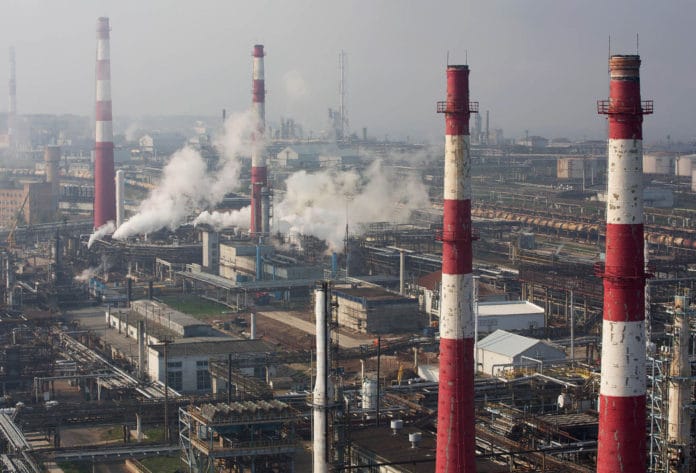OPEC’s deal to cut production and boost prices gives oil companies the opportunity to shake off two years of layoffs and slumping profits to start investing again — if they still have the risk appetite.
Just ask Patrick Pouyanne, chief executive officer of Total. Throughout the downturn he’s consistently warned that tens of billions of dollars of investment cuts around the world will create an oil-supply shortfall within a few years. The situation presents an opportunity for the French producer and refiner, which will consider next year whether to start developing expensive new projects.
The question is, do wary investors really want him to put his money where his mouth is?
“Total must continue to allocate investments cautiously and bank on low oil prices,” Ahmed Ben Salem, an analyst at Oddo Securities, said by phone from Paris. The company should be seeking ways to drive production growth beyond 2020, but only on “projects with break-even of no more than $45 or $50, because the OPEC decision may be valid for just six months.”
There’s no guarantee that Pouyanne is right. While his sentiments have been echoed by other influential figures in the industry such as International Energy Agency Executive Director Fatih Birol, Rex Tillerson, outgoing CEO of energy giant ExxonMobil and future U.S. Secretary of State, says there’s no looming supply gap.
What’s beyond doubt is that the two-year oil slump has prompted an unprecedented wave of retrenchment across the industry. The worst appears to be over after Brent crude, the international benchmark, gained more than 40 percent this year. The rebound accelerated after the Organization of Petroleum Exporting Countries agreed to the first production cuts in eight years.
Still, the price is about half its mid-2014 level and companies remain conservative — cutting spending in order to boost cash flow and protect dividends as debt rises. The biggest project approvals in recent months have focused on expanding existing facilities — BP’s Mad Dog Phase 2 in the Gulf of Mexico, Chevron Corp.’s Tengiz expansion in Kazakhstan — rather than tapping completely new areas.
Investors see plenty of reasons for a company to be cautious, but they also acknowledge that anyone willing to invest now could reap the benefits later, particularly with the cost of developing new resources declining as suppliers cut their prices.
Total was “really under stress” in 2015 and 2016 as it made heavy investments in new projects just as prices plunged, Pouyanne said at a conference in Paris in October. Now, costs paid to service providers have fallen by 30 to 40 percent and there’s a need for new developments so the world can have sufficient supply in three to five years, he said.
Total is preparing for final investment decisions in 2017 to develop the giant Libra deep-water field off Brazil and a large onshore project in Uganda. It’s just signed a preliminary deal to develop a large gas field in Iran and is working toward approval for a second phase of the Zinia offshore field in Angola after reducing the expected cost by half to $1.4 billion.
While the pledged cuts from OPEC and Russia lifted Brent crude above $55 a barrel last week for the first time in more than a year, there’s cause to doubt whether they will be fully implemented. Supply from countries including Libya, Nigeria is exempt from curbs, while some non-OPEC nations are counting natural declines as voluntary cuts. Brent traded at $53.92 a barrel at 10:49 a.m. in London on Friday.
“The industry’s difficult to assess, even if we’re very positive on Total’s fundamentals,” said Benjamin Philippe, a fund manager at Degroof Petercam Gestion in Paris, whose funds are underweight in Total shares, mostly for regulatory reasons. “I always favor companies with a mid- to long-term view. The implementation of the OPEC decision will be key.”
OPEC’s agreement will have no impact on investment decisions next year, Pouyanne told Bloomberg in Paris on Dec. 1. Total “is working on projects that are competitive, regardless of the price,” he said.
Libra and Zinia phase two could be extremely profitable with oil at $50, said Pouyanne. Half the cash Total has allocated for exploration and production spending over the next four years isn’t committed to specific projects, so the company has some flexibility in its investment decisions, he said.
In a sign of growing confidence, the company on Friday reduced the discount offered to encourage investors to take dividend payments in shares — a method many companies are using to conserve cash.
Total has focused recently on reducing capital expenditure to a range of $15 billion to $17 billion a year from 2017 to 2020, compared with $18 billion this year and a peak of $28 billion in 2013. It expects oil and natural gas output to increase by 5 percent annually to 2020, spurred by large projects initiated when crude was above $100. That rate of growth will slow to 1 percent to 2 percent a year from 2021, just as Pouyanne is saying a supply gap could emerge.
“Exploration at $40 per barrel is more complicated than at $100,” said Guillaume Chaloin, a fund manager at Meeschaert Asset Management in Paris, which oversees 2 billion euros ($2.1 billion). “But they have to renew their reserves.”






